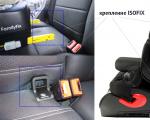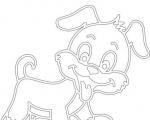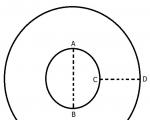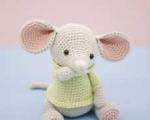Mathematics demonstration material. Why use demonstration materials for kindergarten classes? Download demo material
That is why the educational and educational process at a young age is more successful if the teacher uses various demonstration materials in his work. What is it, and why is it so important to use various forms of visualization?
Tables. This refers to alphabetic or numeric entries placed in a certain sequence. Most often, information is grouped through columns or presented as a series of pictures. It is possible to use accompanying text, but this is not required. Typically, tables are placed on large sheets of paper that can be attached to thick fabric, plastic or cardboard. Depending on the type of information, tables can be:
- reference;
- training;
- instructive;
- cognitive.
Visual materials. This may include posters, paintings, applications, sets of cards depicting various objects or natural phenomena. This also includes demonstration materials in the form of models of measuring instruments and tools:
- dummies of various objects and goods;
- scales;
- clock face;
- models of various measures (liter, meter and others);
- dummies of geometric shapes.

Objects of the surrounding world, natural materials. Such materials can be fruits, vegetables, sticks, cones, pencils, books, toys, flowers, leaves and much more. Most often, this type of teaching aid is used when studying mathematics and the basics of counting. Some objects are also used to demonstrate the basics of geometry. For example, a donut is a circle, a ball is a ball, and a nightstand is a cube.
We use it correctly
Knowledge of the types of demonstration material contributes to their correct selection and use, which is very important for increasing the effectiveness of training. Of course, the modern printing industry makes it possible to acquire all the necessary educational materials without much difficulty. But teaching materials made by the children themselves work much better and more effectively. Therefore, it is necessary to actively involve children in this creative work. This contributes to the development of certain skills, the development of imagination and fine motor skills, and the acquisition of additional knowledge and skills. Further work with demonstration material made with one’s own hands encourages the child to respect the work of others.

But, as you know, everything is good in moderation. It is very important to observe the rule of sufficient and necessary use of material. If you use demonstration material where it is completely inappropriate, you can not only fail to teach children to think correctly, but also completely lead them away from the task at hand. A striking example of a negative impact is this: a child learns to choose the correct arithmetic operation when solving a task. If, to achieve the goal, an illustration is used in which another one comes running to two bunnies sitting in a clearing, the child will find the correct answer by simple counting. At the same time, he will not think at all about what kind of action needs to be applied. The goal will not be achieved. Moreover, in this case, the use of demonstration material, on the contrary, will slow down the formation of the skill of determining the correct action on the proposed numbers.
When teaching preschoolers in kindergartens, visibility plays an important role. Children at this age have developed visual-figurative thinking; it is easier for them to perceive information through actions with objects, feeling and cognizing objects. Therefore, in the classroom the teacher uses a lot of demonstration material, diagrams, paintings, illustrations for fairy tales, and teaching aids. Innovative computer technologies are widely used. Handouts are laid out on the tables for the children, which the kids can pick up, examine, touch, feel. This helps to learn the properties of objects and perform tasks assigned by the teacher.
Production of manuals
Nowadays, many interesting and bright materials are published for kindergartens. All this is purchased by kindergartens and teachers. But each teacher brings his own vision, imagination, and creativity to his work. Therefore, the teacher creates most of the teaching aids with his own hands.
To make the demonstration material for kindergarten beautiful and practical, the following materials are used: bright colored paper, pictures on the topic printed on a color printer, self-adhesive colored wallpaper, thick cardboard, paints, crayons, fabric material, etc. In order for the aids to last longer , the finished picture is laminated.
Getting to know nature
When planning a lesson, the teacher thinks in advance what demonstration material will be needed to master a given topic, searches the Internet for the necessary images and prints the required element. For example, when studying spring flowers in class, you can show slides on TV or a computer with photographs, print or draw the structure of a plant: root, stem, leaves, flower, fruit.

Children will be interested in playing the game “Collect a plant”. For example, a picture of a tulip is cut into several parts, and the child assembles the plant in the correct order, repeating its components along the way.
Learning mathematics in kindergarten
In teaching preschoolers the basics of mathematics in kindergarten, knowledge is given in the following sections: geometric figures, quantitative and ordinal counting, orientation in space and time, the size of objects, dividing a whole into parts, solving and composing problems, studying numbers. Let's consider demonstration material in mathematics that can be used when studying these sections.
Kulikova Svetlana Anatolevna
Hello, dear colleagues!
Summer time is here! It's time for our and our children's holidays. It's time for various entertainments and... regular preparations for the new school year.
We have a new kindergarten, there are many educational games, manuals, toys, but I wanted to do mathematics demonstration material. We all know that it can be different, and the more interesting material, the more colorful, the more both kids and older preschoolers like it. With this material you can come up with a lot entertaining tasks, and solving examples with him is much more interesting.
Once upon a time we made mushrooms, Christmas trees and other items. I also decided to make mushrooms. made them funny.
For example. boletus, a useful mushroom? Yes, useful. Does that mean good? So I made him a kind “face”. And the fly agaric? What is he like? Well, of course - poisonous! So “He got the same face!
I made the strawberry appetizing, bright, and the pyramids turned out to be a joy!
The kids and I have already used this material. It was fun! We came up with different funny math stories. Even the names were given to the mushrooms in these fun puzzles. Indeed, the brighter material, the more interesting, the better the educational process goes!
I hope you, dear colleagues, are also mine I'll like the material!
Good luck to you in preparing for the new school year! And have a good rest!








Publications on the topic:
Good afternoon colleagues! As you know, most children have imaginative thinking. That is why the educational and educational process.
Demonstration material “Kansk: yesterday and today” Slide 3. On the Siberian lands, the first Russian settlements began with small military fortifications - forts. It was a difficult start from prison.
When the question of placing demonstration counting material on a metal board arose, a wonderful idea came up to create one.
Annotation. Didactic material is intended to reinforce the ability to identify objects by color and size. For development in children, younger.
Every child in kindergarten gains experience of emotional interaction with adults and peers. Much of this communication depends.
Notes on mathematics in the second junior group “Teach the bunny mathematics” Goal: To familiarize children with geometric shapes. Enriching children's understanding of geometric shapes. Tasks. Educational:.



